

 The South African
The South African
Allan Sinclair is the Curator of the Military Art Collection at the South African National Museum of Military History
One of seven officially appointed South African artists of the Second World War, Leslie Thomas (Ben) Burrage (1909-1983) almost always made a point of describing in writing what was being depicted in his paintings and drawings. We are fortunate that these descriptions have been preserved along with the collection of works of art at the South African National Museum of Military History, Saxonwold, Johannesburg, where they are a valuable source of reference for the works themselves.
Burrage's main contribution to the war art scheme was his depiction of the activities of the South African Engineer Corps (SAEC). The following article will serve to highlight the fine record created by Burrage to illustrate the work carried out by the SAEC in Italy. The contemporary and later notes made by the artist are as much a part of the collection as the paintings themselves, as they round off the images created in the works of art.
The South African Engineer Corps in Italy (1943-1945)
The Italian theatre of the Second World War favoured the German defenders more than the Allies, owing mainly to the nature of the Italian topography which the Germans exploited with skill and precision. Amongst other things, every bridge and tunnel on the line of their retreat northwards was demolished. Allied engineering units were therefore very much in demand in maintaining the rate of advance along this destroyed highway system.
The SAEC played a substantial role in the campaign. Their diverse units were in support of both the British 8th Army and the United States 5th Army which, together, formed the Allied 15th Army Group tasked with the liberation of Italy. The units which fell under the General Headquarters were the railway construction, harbour construction and tunnelling companies deployed to repair the damage caused by both German demolitions and Allied bombing; the engineer base workshops supported by a compressed gas depot; the survey companies and a large number of road construction and maintenance companies vital for keeping open the lines of communicatiqn. Other units included a group of field companies in support the 8th Army, a field squadron in support of the 6th South African Armoured Division and various specialised units such as water supply, maintenance and treatment companies, geological survey sections, camouflage and railway or docks operating companies (N Orpen and H Martin. 1982: forward). The motto of the SAEC, ubique, which means 'every where', is extremely appropriate when looking at the Italian Campaign (1 L Keene, ed. 1995 202). In recognition of the SAEC's outstanding achievements during the war, His Majesty King George VI granted the corps the privilege of wearing the nine flamed emblem of the Royal Engineers (Orpen & Martin. 1982: Emblem)
Ben Burrage and the War Art Programme
In November 1943, L T Burrage was appointed as one of seven official South African war artists. Not wanting to repeat the error of not having preserved in any real manner a record of the role played by South Africa during the First World War (1914-1918) the South African Government set up programmes to preserve for posterity the details of the country's participation in the Second World War (1939-1945). One of these programmes was the appointment of official war artists to depict in works of art the activities of the Union Defence Forces (UDF) and related matters (C Kruger. 1990: 48).
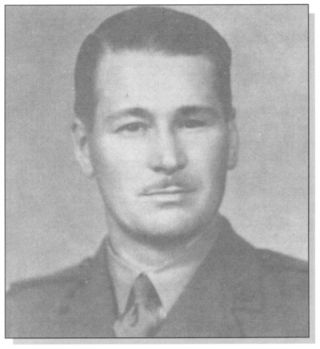
Burrage himself originally attested in the SAEC during the early years of the war and he served with the Concealment and Camouflage Section, his role being to illustrate instructional pamphlets and posters on camouflage. His appointment as a war artist took him to the Middle East and Italy where, amongst other things, he recorded some of the activities of the various SAEC units, such as the repair work undertaken in Ancona Harbour. After a period of service back in South Africa, he was officially requested by SAEC Headquarters to return to Italy to record more of the work being carried out by the sapper units there. These included the reconstruction of many bridges and repairs to the damaged Mount Cenis Tunnel between Italy and France (N P C Huntingford. 1981: 5,6).
The paintings and descriptions of the SAEC activities in Italy
As will be seen by studying the seventeen paintings presented below, Burrage's portrayals of the SAEC at work are remarkably realistic and the artist took great pains to record the finest detail. While headings, type of media used and dates have been added for the interest of the reader, the descriptions provided below are in Burrage's own words.
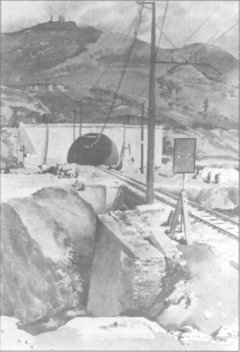
Later note by artist, February 1980:
'The restoration of the rail link
from Prato to Bologna (approximately 80km) through the Appennines
was essential for the successful Allied advance in central Italy,
and was the most impressive achievement of the Railways
Construction and Tunnelling Companies, SAEC, during the war. The
painting shows the repaired southern portal of the 19 km
Appennino Tunnel. Above the portal, the massive demolition
caused the mountain side to slide down, necessitating considerable
shoring against the sideways pressure. The demolition also
dammed up the drainage water which flooded the tunnel for some
600 metres to the north. A further complication was that the road
bridge on top of the portal had to be kept open throughout the
construction work as it carried the main Allied route to the battle
area.' (Official World War II Art Catalogue, Cat No 1012, SANMMH).
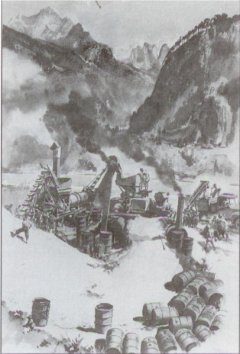
Contemporary note by artist:
'25, 27 and 31 Companies which
make up the Roads Group, SAEC, have been engaged in constructing
and maintaining roads from Cassino right up to Austria. The plant
shown here heats crushed stone removes the loose dust which is
blown off in a white cloud, and then adds the clean stone to
heated bitumen in carefully controlled quantities. The rated
capacity of this machine, which is mobile, and so facilitate's operation
over a wide area, is a daily output of 200 tons of bitumen pre-mix
used for roads surfacing. The bitumen heaters in the foreground
were developed by the Roads Group during the campaign in the
desert and are known by the nickname, Queen Mary.' (Official
World War II Art Catalague, Cat No 1028, SANMMH).
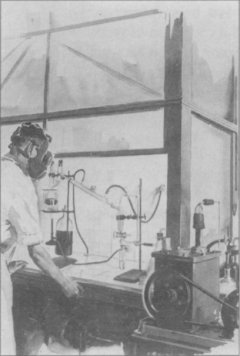
Contemporary notes by artist:
'23 Anti-gas Laboratory (Field Section) SAEC, has done much
valuable and often dangerous work in the realm of chemical warfare.
Their numerous tasks have included analysis of new enemy
explosives and jet-propulsion fluids, and testing of enemy anti-gas
equipment. The illustration shows a staff-sergeant of this unit distilling
a mustard gas sample from a shell charging in order to determine the
degree of deterioration, the apparatus being set up in a fume
cupboard in their laboratory in Rome. A high vacuum pump (right
foreground) creates a partial vacuum throughout the apparatus,
which lowers the evaporation point of the liquid gas. A series of
chemical filters grouped behind the pump prevent any of the deadly
fumes from reaching the pump and contaminating the laboratory. The
respirator is an added precaution.'
(Official World War II Art Catalogue, Cat No 1082, SANMMH).
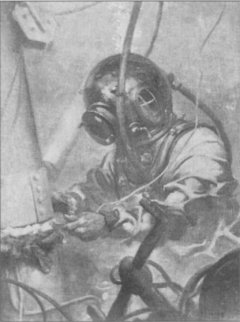
Contemporary note by artist:
'The painting was made from notes on colour and atmosphere after a
descent (by the artist) in Ancona Harbour (on the Adriatic coast of
Italy) on 29 August 1944. It shows a diver of 41 Harbour Construction
Company, SAEC, inserting an electric detonator into a ring of
plastic explosive he has pressed around the mast of a sunken ship.
This was part of an extensive clearing operation undertaken by
the sappers in the badly damaged harbour to restore the berthing
facilities for Allied shipping.'
(Official World War II Art Catalogue, Cat No 1083, SANMMH).
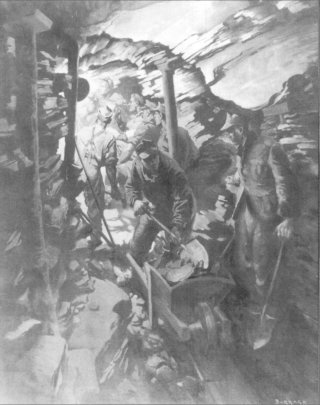
General note applying to a series of seven illustrations completed by
the artist:
'The Mount Cenis Tunnel, on the railway line between Turin and
Paris, is 12,5 km long and cuts through the Western Alps. The
tunnel was demolished at both ends by the Germans, blocked by
debris and barbed-wire entanglements, heavily mined and booby
trapped, and flooded for over 3 km at the eastern end. This was the
SAEC's last final major assignment of the war and 61 and 62
Tunnelling Companies, operating respectively from Bardonecchia at
the Italian end and Modane at the French end, were detailed to clear
and repair the tunnel. After considerable progress, the South
Africans were recalled to South Africa and the task had to be
completed by Italian and French contractors.' (N P C Huntingford.
1981:9).
Contemporary note by artist:
'Mount Cenis Tunnel - Bardonecchia end: Although it was
possible to climb over the huge heap of fallen rock in the first
demolition, the second demolition was a complete blockage. Thus a
small exploratory tunnel had to be driven through the top of the
second break in order to find out how far it extended. The painting
shows German POWs, supervised by South African engineers,
excavating this small tunnel. As this was being cut through the demolition
itself, great care had to be exercised, as there was considerable
danger of the fractured rock falling or caving in. When they finally
holed through, the engineers found the demolition to be roughly the
same extent as the first one, with about six million gallons of water
dammed up behind it.'
Later note by artist, 10 April 1979:
'The work was executed by 61 Tunnelling Company, SAEC.'
(Official World War 11 Art Catalogue, Cat No 1169, SANMMH).
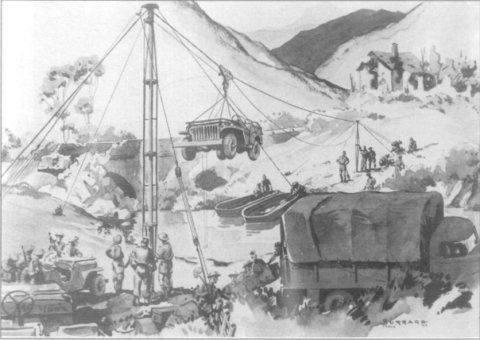
Contemporary note by artist:
'This cable-way, designed and constructed by 82 Engineer Base
Workshops, SAEC, was used with great effect for ferrying jeeps and
6 pounder guns across narrow gaps during the Italian Campaign.
It is designed for rapid erection, and can be operated within an hour
and a half of arrival at the scene. Automatic and hand operated
brakes on the carrier enable the raising and lowering and return
journey to be worked from one winch on the tower on the near
bank. The load runs to the far bank by gravity. An unlucky
accident caused the death of one of the engineer
officers responsible for the development of this
device. ' (Official World War II Art Catalogue, Cat No 1207, SANMMH).

Contemporary note by artist:
'The German locomotive in the foreground fell in
the river bed, damming up the water, when the
original structure of this bridge at Sacile collapsed. It had to be
dragged out of the way before 61 Tunnelling Company, SAEC, who
built the bridge shown here, could commence work. Further back a
temporary bridge, carrying a deviation line, can be seen. The
tapered girder on the right of the drawing is a launching nose, used
to support the weight of the bridge proper as it is pushed out
over the gap. The nose is then removed and the massive girder is
lowered by means of jacks into its final position on the concrete
abutments.' (Official World War II Art Catalogue, Cat No 1217, SANMMH).
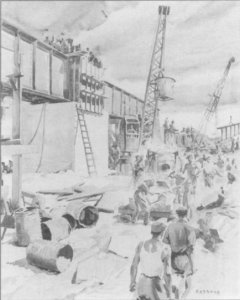
Contemporary note by artist:
'This bridge is near Conegliano, also on the main line to north-eastern
Italy. Eighteen of the original spans were destroyed by bombing, and many
of the piers had to be rebuilt by 38 Railway and 61 Tunnelling companies
who handled the repair job. The bridge, 15 000 ft long, spans the Piave,
known as the "Sacred River" because it was here that the Austrians were
finally held after the breakthrough at Caporetta during the 1914-1918 War.
A large memorial, commemorating the event, stands on a nearby hill.
Although, at the season the sketch was made, the river is only a broad
stretch of dusty stone with perhaps a couple of small streams trickling
down, after heavy rains in the mountains to the north or when
the snow melts it can become a raging torrent the whole width of
the river bed in a few hours.'
(Official World War II Art Catalogue, Cat No 1218, SANMMH)
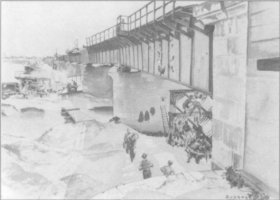
Contemporary note by artist:
'[Thirty-six] odd miles east of the Piave River, near Codriopo,
the main line to Austria and Trieste again crosses another
very wide river, this time the Tagliamonto. The half-mile long
double track bridge has 36 spans, and of these only four
remained in place after the heavy Allied bombing. 39 Railway
Construction Company and 62 Tunnelling Company, SAEC, who did the repair work,
could use only 26 of the original 72 trusses when building a single
track line through. Sixteen of the piers and the east abutments had
to be reconstructed. When the drawing was made, all but two of
the trusses, one of which can be seen being repaired to the left of
the bridge, were on the piers, although the one in the foreground,
on which shrapnel can be seen, is still out of line. A Bailey
pier is being erected under this so that it can be jacked into position.
The river in the sketch is a mere trickle but a little over a fortnight
later, just after the bridge was finished, it rose to almost the level
of the lower part of the trusses.'
(Official World War II Art Catalogue, Cat No 1219, SANMMH)
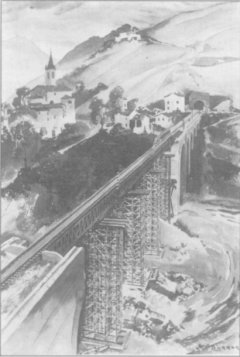
Contemporary note by artist:
'Also on the Prato - Bologna line is this bridge near Grizzana, 39
Railway Construction Company, SAEC, who effected the repair, put
over six UCRB (unit construction railway bridging) spans each 75 ft
long. Five of these rest on LSST ('light single story' truss) piers, while
the sixth strengthens the original arch on the far side. Men working
on one shift here had a narrow escape when one of the stone
arches and piers, weakened by the demolition, collapsed soon after
they had left. Activity in this area began to draw enemy fire, and
so the spans of the new bridge were run into the tunnel shown in
the sketch and kept there until the Germans had been driven further north.
Then it was run out and launched onto trestle piers, which had survived
the shelling with only minor damage.' (Official World War II
Art Catalogue, Cat No 1220, SANMMH).
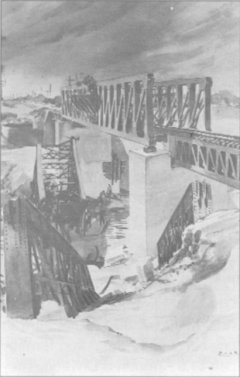
Contemporary' note by artist:
'Originally a double track through span, carrying the main line to
north-eastern Italy, this bridge was found to be completely demolished
when the Allies reached the town of Padua. Repair work was
carried out by the 40 Railway Construction Company, SAEC. The
damaged piers were cut away to foundation level, and wreckage
cleared where necessary. New piers and abutments of mass
concrete were then constructed to take two spans 90 ft long of UCRB
(unit construction railway bridging) and a central 165 ft through truss.
Two points of interest attached to the construction of this bridge: it
was the first time in this theatre that a through truss of this length had
been used as a skew bridge (that is, at an angle to the direction of the
piers) or had been launched on rollers. The rollers used were
UCRB receiving rollers, designed to take a load of only ten tons - but
they stood up to the 80 tons weight of this massive truss, much to the
relief of the engineers in charge, and the launching was successfully made.'
(Official World War II Art Catalogue, Cat No 1221, SANMMH).
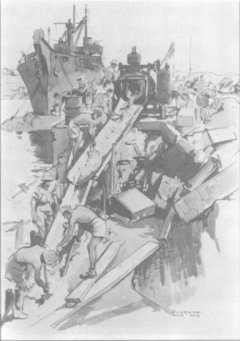
Contemporary note by artist:
'Repairing a crater in a quay-wall - Ancona harbour. The Germans, using "G" mines,
blew huge craters in most of the quay walls in Ancona harbour. In
this sketch, sappers of a harbour construction company are filling
one of these craters. Divers have cleared the rubble to the foundations
and have placed a wooden shutter on the wall face, and the
gap behind is being filled with concrete. As soon as this
concrete has replaced all the sea water behind the shutter, a front
wall will be constructed, the hole behind this filled, and a
new surface created on top. The operation shown here is one of
21 similar jobs so far being completed in Ancona harbour
by this SAEC company. In the background is a Royal Engineer
salvage ship lifting a sunken lighter. Italian pioneers provide
labour for the South Africans.'
(Official World War II Art Catalogue, Cat No 1231, SANMMH).
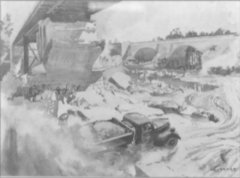
Contemporary note by artist:
'These bridges, carrying the main road and rail routes to north-eastern
Italy, Trieste and Austria, were both almost completely
demolished by bombing. Corps troops, consisting of 1, 11 and 13
Field Companies and 22 Field Park Company, SAEC, were given
the task of repairing them. The road bridge is a Bailey utilising
some of the damaged piers of the original bridge for support. It was
named 'Jan Smuts Avenue", after the Prime Minister of South Africa.
This is also the name of a well-known road in the suburbs of
Johannesburg. The rail bridge, not far from completion in the sketch,
has been repaired in concrete.'
(Official World War II Art Catalogue, Cat No 1234, SANMMH).

Later note by artist, January 1980:
'This double-triple Bailey bridge was built by the South African
engineers of 12 Sduadron forming part of 6 Armoured Division. They
named it "Ultimate Effort", thinking, mistakenly as it turned out,
that it was their last job in Italy. The bridge spans a massive
horseshoe shaped demolition on the mountain road above Exille. Exille
is a small village to the west of Turin on the route to Bardonecchia
clustered around an old fort (centred in the background of
the picture) built by Napoleon to defend the French border against
possible Italian aggression.'
(Official World War II Art Catalogue, Cat No 1235, SANMMH).
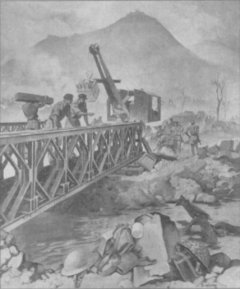
Contemporary note by artist:
'This bridge is the first over the Rapido River and it is part of a
magnificent feat performed by the SAEC in pushing roads
through the devastated area. Here it is seen nearing completion
as it appeared the day after Cassino fell before the Allied
breakthrough. The ruins of Cassino (the village) can be seen in the
background below the mountain on which Cassino monastery was
built. This work was carried out under enemy observation from
Monte Cairo which necessitated the use of continuous smoke
screens.
(Official World War II Art Catalogue, Cat No 1258, SANMMH).
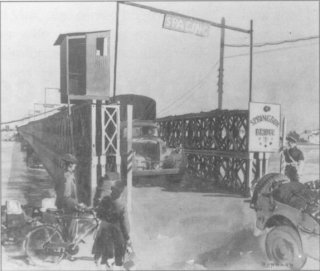
Contemporary note by artist:
'Designed from recce photographs taken from the air while the River
Po was still in enemy hands, this bridge was built and tested at
Consentico a month before the Po area fell before the advance of the
Allies. Constructed of triple-double, reinforced Bailey, it had a
continuous length of 1 010 ft, being pinned at one end, floating at the
other and running on rollers on all three piers. The spans measure 220
ft, 275 ft, 275 ft, and 220 ft, and it was built by two field companies
and one field park company SAEC, using two Italian pioneer companies
as labour, in the remarkably short time of eight days. The SAEC
officer responsible for the design flew to England to consult with Mr
Bailey regarding the special reinforcing needed by exceptionally
long spans. It is classified as Class 40; restricted and very careful
control is exercised on the spacing of vehicles using it. At the
time this drawing was made, heavy rains in the Turin area had raised
the river level at Ferara by 17 ft, making the pontoon bridge upstream
unusable, and so the Springbok Bridge was carrying both
the north and southbound traffic at this busy centre.'
(Official World War II Art Catalogue, Cat No 1271, SANMMH)
Later note by artist, 30 January 1980:
'A sapper of 41 Harbour Construction Company, SAEC, helped by
Italian pioneers, cutting a thread on a 6-inch pipe to be used in the
repair of the harbour. Ancona was one of the biggest reconstruction
jobs carried out by the company. The sapper is wearing one of the
original issue of helmets (of which the possessors became very proud)
on which the SAEC flash can be clearly seen.'
(Official World War II Art Catalogue, Cat No 1729, SANMMH)
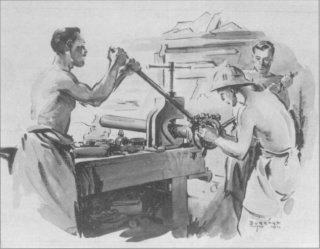
Conclusion
Burrage was clearly proud of his association with the sappers, an association which was to last the rest of his life. After the war he became an active member of the Sappers Association. He was involved with the design of the Hall of Remembrance at Sapperrust near Hartbeespoort Dam and served as editor of SA Sapper, the official magazine of the Association. His death in May 1983 was mourned by many ex-sappers all around the country (SA Sapper, June 1983)
The works shown above, along with those by other war artists in the colledion at the SA National Museum of Military History play an important part in recording and preserving our country's military heritage Ben Burrage's work in particular will always serve as a lasting testament to South African sappers who served in the Second World War
Bibliography
File 920 - Burrage L T, South African National Museum of
Military History Archives: Obituary in SA Sapper June 1983
Huntingford, N P C, The World War Two works of Ben Burrage, (South
African National Museum of Military History, Johannesburg: 1981)
Keene, J L (ed), South Africans in World War Two, a pictorial history (Human & Rousseau, Cape Town: 1995)
Kruger, C, South African Images of War, (South African National Museum of Military History Johannesburg: 1990)
Unpublished Official World War II Art Catalogue, South African National Museum of Military History
Orpen, N & Martin, H J, Salute the Sappers, Part II (Sappers Association, Johannesburg: 1982)
Return to Journal Index OR Society's Home page
South African Military History Society / scribe@samilitaryhistory.org